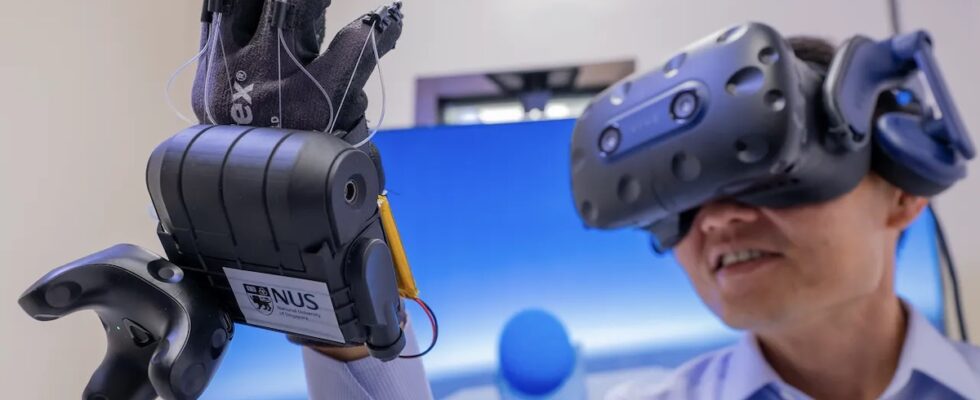HaptGlove uses haptic feedback to enhance users’ virtual experience. Image: National University of Singapore.
Researchers at the National University of Singapore are creating gloves that will allow users to more realistically experience the “feel” of objects in virtual environments. Presenting their creation as different from existing technologies, they claim that the HaptGlove applies real-time pressure to the fingertips and simulates the texture of objects.
The glove leverages haptic feedback and pneumatic control that are integrated with the researchers’ microfluidic sensing technology. According to the university team, this reduces the size and weight of the glove, without the need for bulky accessories.
HaptGlove features five pairs of haptic feedback modules, one for each finger, which are wirelessly controlled to read the virtual reality object for its shape, size, and texture. A microfluidic pneumatic penetrator applies real-time pressure to the wearer’s fingertips, allowing them to “feel” the contact as the avatar touches, grasps, and moves the object in VR. The glove further limits the position of the wearer’s fingers to simulate the shape and texture of the object.
Virtual reality and realistic touch
The researchers note that while haptic gloves are not new, products currently available on the market generally use vibration motors and do not provide a realistic touch sensation. For example, they cannot accurately simulate the shape or hardness of a virtual object.
Others use pneumatic actuators to generate a feeling of pressure, but they are often cumbersome and limit user movement.
“My experience with virtual reality and the metaverse has always been unsatisfactory,” says Lim Chwee Teck, director of the Institute for Health Innovation and Technology at the National University of Singapore, who leads this research team. “Virtual reality should not be limited to a visual and auditory experience. It should offer the possibility of interacting with virtual objects. However, current methods of tapping on a virtual panel or interacting with another avatar do not provide the touch sensation that we experience in the real world. »
Patented prototype
Thanks to the software developed by the researchers, the HaptGlove displays a visual-haptic delay of less than 20 milliseconds, which the research team says is faster than conventional haptic gloves. Weighing 250 grams, it is also lighter than competing products on the market, which weigh 450 grams.
The HaptGlove was conceptualized in 2019 and a prototype was developed two years later, with 20 users recruited to test the product.
The researchers have filed for a patent and are looking to bring the glove to market within two years, with the goal of doing so at half the price of products currently on the market.
The efforts are led by the Microtube Technologies unit, spun off from the University, which focuses on developing sensing technologies for games and metaverses.
Source: ZDNet.com
